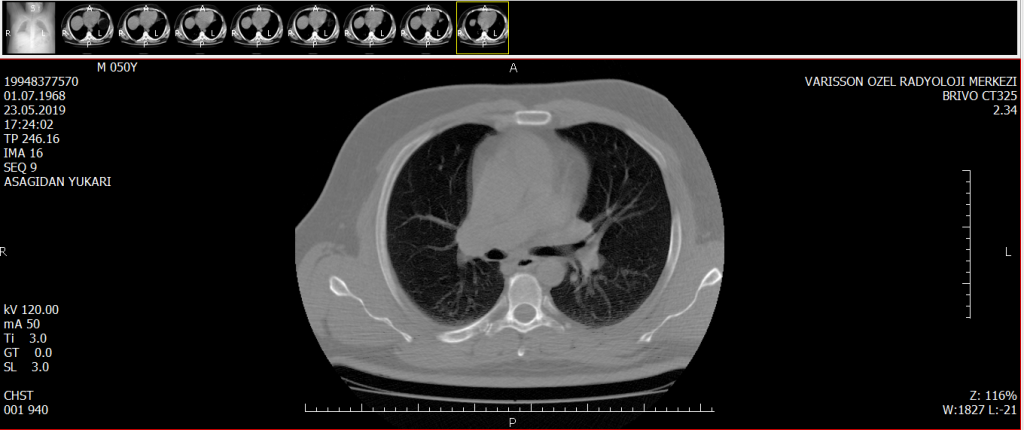Our Center -1. It serves our patients with the computed tomography device located on the 1st floor. You can read our informative article about the computerized tomography examination below, and you can contact us at our contact numbers for your questions about the examination.
What is Computed Tomography?
Computed tomography (CT) is one of the most commonly used diagnostic imaging methods in the field of Radiology in current medicine. CT creates images by processing tomographic images with the help of computer and provides detailed visualization of the internal organs of the patients. Contrary to ultrasonography, it provides visualization of deep-seated organs and deep anatomical formations as well as superficial tissues. As the working principle of the CT device, it creates an image with a type of radiation called x-rays. For this reason, this examination cannot be performed in cases where radiation exposure is strictly prohibited, and other imaging methods are used instead of this method.
In which situations is computed tomography (CT) performed?
Computed tomography is one of the main examinations that can be performed in cases where the internal organs must be imaged. Some of the situations that require CT examination are listed below;
Internal organ injuries in traffic accidents or other accidents
Imaging of brain tissue (especially stroke and stroke disease)
Bone fractures, musculoskeletal injuries
Detection of cancerous tissues or follow-up after treatment
Preoperative, pre-radiation, pre-biopsy evaluations
Detection of internal bleeding
Follow-up of treatment / follow-up of recovery
Diagnosis of vascular diseases
Imaging of infectious diseases
In many diseases not included in the list, CT examination can be performed when necessary. However, since it is an examination containing radiation, its use should be avoided in cases where medical justification is not appropriate.
What are the possible side effects of CT examination?
It is an examination involving radiation.
For this reason, CT scans should be avoided in pediatric patients unless definite medical reasons are provided. However, in cases where there are definite medical reasons, children can also be tested. Traffic accidents, forensic cases and events, child abuse or situations that cannot be diagnosed with other methods can be given as examples.
In addition, CT examination should be avoided in pregnant women or patients with suspected pregnancy, without the condition of absolute medical necessity. Due to the harmful effects of radiation on the fetus in the mother’s womb, tomography examination should not be performed in pregnant women unless there is an exceptional situation.
Contrast material can be given intravenously in the examination.
In many CT examinations, a drug called a contrast agent (opaque substance) is given during the procedure, which provides a much better visualization of organs and vessels. If the patients have a history of allergy to this substance, which is also known as color film among the people, the examination is performed without administering this substance. Therefore, every patient is questioned in terms of allergy before the procedure. It is also known that this opaque substance administered intravenously can affect thyroid functions in thyroid diseases.
The use of intravenous contrast agent is restricted in people with kidney failure or suspected kidney disease. Because the drug can impair kidney functions. This issue should also be evaluated by the relevant physician before using the drug in very old people or people with poor general condition.
It is recommended to obtain information from the relevant physician about other exceptional cases related to the use of contrast agents.
What are the conditions that need attention before the examination?
If the tomography examination is to be performed with intravenous drug administration, it should be performed after 4-6 hours of fasting. In cases where no medication is given, the procedure can also be performed on a full stomach. In some cases, oral medication can also be administered. In such cases, the patient should be informed before the examination, and a suitable time should be allocated for oral intake before the procedure. For exceptional cases other than these, preparations should be made for necessary matters by consulting with the relevant physician before the examination. During the examination, if a metal object is found in the area where the examination will be performed, metallic objects such as credit cards, earrings, coins, etc. Objects that are surgically placed in the body, such as metal prostheses, heart valves, pacemakers, etc., are not an obstacle to the tomography examination.
What are the conditions to be considered after the examination?
After the examination, if the drug is given intravenously, it is recommended that the patient drink plenty of water. This facilitates the excretion of the drug from the kidneys. In addition, in patients given intravenous drugs, the patient should be kept under observation for a minimum of 15-20 minutes in order to monitor the possible allergy status. In this way, if an allergy develops during or after the procedure, immediate intervention can be performed. However, drug-induced allergies are rare. Drug use should be avoided in elderly patients, but in cases where it is absolutely necessary, the patient should be followed up in terms of kidney functions if necessary. In case of possible discomfort after the procedure, the relevant physician should be contacted.


